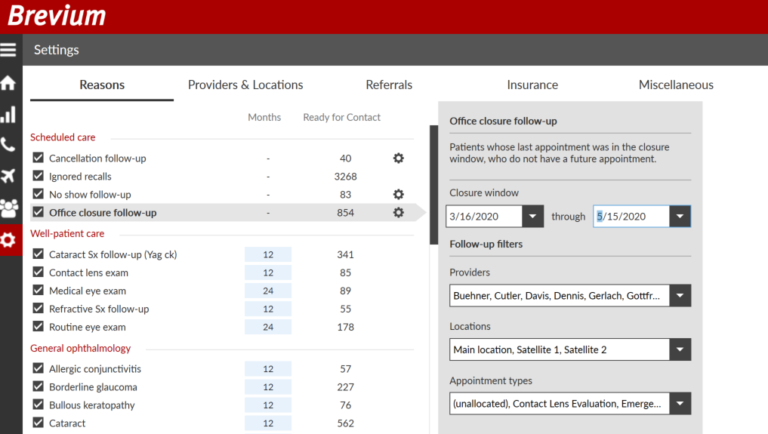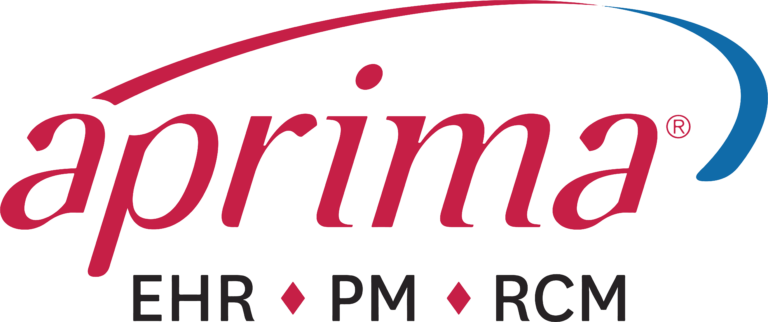The Brevium Blog

Patient Engagement Strategies and Communication Practices
Successful practices often face the inevitable truth that some patients will slip through their fingers. As practices grow, it becomes increasingly difficult to keep track of all the patients coming and going through the door and if left unmonitored, it could lead to a significant loss for both the patient and practice. This is where patient reactivation efforts come in. To keep it simple, patient reactivation is the process of identifying and bringing back patients who are lost or overdue for care. While losing patients comes with the territory of operating a growing practice, reactivating these lost to follow-up patients will ultimately improve patient care while boosting your practice’s bottom line.
Why is Patient Reactivation Important?
Losing patients is costly for all parties involved and could be prevented through effective patient retention and reactivation. Lost to follow-up patients provide a well of opportunity not only because they know how your practice functions and the services offered, but that they aren’t nearly as expensive to reactivate as marketing to new patients. Studies show that acquiring a new patient is at least five times more expensive than retaining or reactivating an existing one. With patient reactivation, your practice no longer needs to waste all its precious time and money marketing for leads that may not turn into loyal customers; instead, some of those resources should be spent reaching lost to follow-up patients and nurturing those relationships back to loyal, satisfied customers.
While practices heavily profit from patient reactivation strategies, effective outreach benefits the patients just as much—if not more. Bringing overdue patients back for treatment invites them to actively participate in their own healthcare with the hopes that better care will lead to an elevated quality of life. Though patients go inactive for a variety of reasons, an aspect to consider with some overdue patients is that those without background knowledge in healthcare may not understand the importance of ongoing treatment. Patients tend to get busy, and their healthcare often falls to the back burner—especially if their conditions aren’t affecting their daily lives. It’s up to you to follow-up and stress the importance that preventive care and needed treatment will only benefit patients long term by helping them stay healthy and reducing the risk of disease or disability.
Despite the low costs and high ROI associated with patient reactivation, only 30 percent of practices implement these strategies into their marketing plans. Allowing patients to disengage is costly because the next time they need to schedule a follow-up, they might look elsewhere for those services. Having a strong reactivation strategy in place will not only prevent your practice from losing needed business and revenue but will help get those overdue patients back through the door for treatment they need to live a better life.
Why Do Patients Stop Coming to Your Practice?
Patient reactivation efforts become much harder when you don’t know the reasons why the patient went inactive in the first place; otherwise, you risk wasting time and resources on potential dead ends. Once you’ve established why the patient may have gone inactive, you can target these patients using strategies specific to why they left. Patients often go inactive for reasons that are out of the practice’s control; however, here are a few preventable reasons why patients may slip through the cracks:
- No communication or follow-up from the practice
- Cancel or no-show appointments with no reschedule
- Better deals or services offered by competition
- Patients don’t feel valued or respected
- Long wait times/inconvenience
- Bad experience with practice or provider
Understanding why your patients went inactive should be your very first step in your campaign to win them back; otherwise, you might risk using reactivation strategies that have nothing to do with their situations or experiences with your practice. Use your resources to establish a strong connection with them that will motivate and incentivize them to return for your services.
How to Go About Reactivating Patients?
Most practices know that patient reactivation is important but often fall short of achieving their goals because their current efforts don’t align with the most effective reactivation methods and strategies. Here are the steps your practice should take to maximize your patient reactivation efforts:
- Identify lost to follow-up patients
The first step to reactivating patients is to identify which patients are overdue for treatment. Depending on the diagnosis, some patients could be considered overdue sooner rather than later.
An important part of this step is to make sure you do not try to contact all of your inactive patients at once; instead, try to reactivate patients that will best fit your practice’s needs at the time. Brevium’s software has the capability to mine your practice management system and collect data on any patient’s demographic, billing/treatment codes, dates of service, and more. With this additional information at the tips of your fingers, you could determine who to reactivate and when based on which providers have openings, practices with availability in a patient’s area, and so on. But even without a software, you can use the information you have in your management system the best you can to determine which patients would be best to contact for treatment to meet your practice’s needs. Segmenting patients and staggering outreach efforts will help ease the workload for your staff; plus, reaching out to patients who have certain conditions to schedule with providers who specialize in them will only increase the chances of patients responding.
- Segment patients based on why they stopped coming back.
Once you’ve identified your lost to follow-up patients, it’s essential to understand why these patients went inactive to develop an effective plan to win them back. If you cannot tell why a patient went inactive based on their histories, it might be worth sending out an incentivized survey requesting they answer a few key questions regarding their inactivity. Include a worthy discount that would motivate patients to respond; after all, the most important part of this step is getting answers. Your findings could aid your practice in determining who to contact so you don’t waste time and resources on dead ends.
- Address ways to entice them to come back based on why they left.
Once you’ve separated patients based on their reasons for inactivity, contact them with a purpose. Most of the time, that purpose will be motivating these patients to schedule appointments. Use their history with your practice to your advantage and create a personalized, time-sensitive offer specific to their diagnoses that will incentivize patients to become engaged in their own healthcare. Utilizing time-sensitive offers especially creates a feeling of urgency that will motivate patients to get back for treatment.
- Make readmission easy.
It may come as a shock, but patients happen to value convenience above all else. According to NRC Health’s Market Insights, 51 percent of the surveyed 223,000 people considered convenience and access to care to be the most important factor in who they treated with; in fact, convenience topped other important factors such as health insurance coverage, provider conduct, practice reputation, and quality of care. With this information in mind, it’s vital for your reactivation strategy to remove areas of frustration from the readmission process so they are more willing to come back. Anticipate the needs of your patients and provide them with the necessary information they will need to schedule an appointment.
- Prepare your staff.
Before you start reactivating patients, first ensure your staff has the necessary tools and training to be successful; without these measures, you’re setting them up for failure. Set expectations with your staff regarding the effect of your reactivation efforts such as knowing which patients you’re contacting and how many contacts are going out, so no one is surprised by which inactive patients call in nor the total amount of inbound calls. Also be sure to train your staff on the questions to ask lost to follow-up patients and information to verify to get these patients back on track. When your staff is equipped to handle the effects of your patient reactivation efforts, those contacting your office will likely have a positive experience and in turn will trust you with their healthcare.
- Measure your success.
Once your team is prepared and your reactivation plan has gone into effect, it’s critical to track your success so you know what works. To truly measure your success, you must first know how many contacts were sent and for which reasons the patients were contacted. Track the communication methods used to contact these patients and find which strategies are most effective for your practice. Perhaps the most important data to measure would be the amount of revenue the reactivated patients bring in and if your efforts have been worth it. If the results aren’t what you expected, go back to the drawing board, and find the weak areas in your healthcare marketing strategy. Consider using a software to aid with this process as it would provide your practice with accurate information over extended periods that would be organized in one place.
- Use a software.
Many practices likely already have a reactivation plan in place; however, many plans that do not use software to aid the process tend to become time-consuming or difficult to maintain, especially as practices experience staff shortages nationwide. Investing in a software that assists with patient reactivation helps cover where staff and patients fall short. Reactivation software can identify patients, contact them and measure your success so you don’t have to waste valuable time doing so manually. While there are only a handful of systems that specialize in patient reactivation, there is software that will help you retain both your current patients and those you reactivate while assisting with recalls before reactivation steps in. Here are a few software solutions that could help you with your patient reactivation and retention efforts:
Patient Communication and Engagement Software
Investing in patient communication and retention software aids your practice with getting more patients through your door for less time, stress and money. This type of software aims to save your staff from spending countless hours handling tedious tasks and instead, allows your staff to focus on higher priorities. Many practices face similar challenges in that they’re often busy, understaffed and struggle with the onslaught of cancels and no-shows. Patient communication software offers a solution to these problems by providing personalized messaging that allows practices to offer quick and easy online scheduling, text appointment reminders, send post-appointment follow-ups, and so on, that keep your practice top-of-mind for your patients. Most communication software on the market also have patient recall software systems in place that notify patients when they are due for treatment. Depending on the recalls’ effectiveness, these notices can help lessen the number of patients that fall inactive. The ideal outcome of investing in this type of software is to make communication between practice and patient as effortless as possible.
Perhaps the most important outcome from implementing a patient communication software is that patients will become more engaged in their own healthcare and begin to improve the patient-provider relationship and overall treatment experience. Practices are often held to the same standard as any other consumer-driven industry; therefore, it’s paramount that your practice treats its patients with the respect and compassion they both expect and deserve from those in control of their treatment. Implementing effective communication strategies with your patients will ultimately boost your credibility and establish a line of trust that will keep your patients coming back.
Patient Reactivation Software – Brevium
While most companies you come across focus more on patient communication and retention, Brevium’s specialty is patient reactivation. This patented software has the means to integrate with your practice management system and mine the data based on procedure and diagnosis codes in addition to identifying patients based on when they were last seen, which gives the practices utilizing this system a much better handle on which patients are overdue and why they are needed back for treatment. Ultimately, a software such as Brevium’s allows practices to strategically follow up on the high risk and high value patients. Whether the goal is targeting high risk patients or filling your providers’ schedules, integrating Brevium’s software into your practice’s system saves time and manpower on manually reactivating patients and instead, opts for allowing the software to identify overdue patients, contact them and measure the success of any given outreach used.
The Most Cost-Effective Preventive Recall Systems
When considering preventive recall systems, the least expensive options typically involve automated communication methods such as emails and texts. These methods are inexpensive due to their minimal resource requirements and high automation capabilities. Here’s a breakdown of the average costs associated with different recall types:
- Email: The cost of sending an email is virtually negligible, often just a fraction of a cent per email. This makes email one of the most affordable options for preventive recall, though its effectiveness can be limited if patient contact information is outdated or emails are filtered as spam.
- Text/SMS: Sending a text message generally costs a few cents per message. While slightly more expensive than email, texts tend to have higher open rates and quicker response times, making them a valuable, cost-effective recall method.
- Autocalls: Automated phone calls can cost anywhere from a few cents to a few dollars per call, depending on the provider and volume of calls made. Autocalls can be more personal and effective but may be perceived as intrusive by some patients.
- Direct Mail: Traditional mailings, such as postcards or letters, cost significantly more per piece. So, that’s important to keep in mind. While effective for certain demographics, the higher costs can add up quickly, making this method less feasible for large-scale recall efforts.
While each recall type has its own costs and benefits, using a comprehensive patient reactivation software like Brevium can streamline these efforts and optimize your ROI. Brevium’s system integrates multiple contact methods, allowing practices to automate and personalize outreach through emails, texts, and autocalls. This multifaceted approach ensures higher reachability and engagement at a fraction of the cost of manual processes.
By leveraging Brevium’s data-driven platform, practices can efficiently manage and execute preventive recalls, minimizing expenses while maximizing patient reactivation success. Investing in such a solution not only enhances patient care but also significantly improves your practice’s bottom line by reducing the need for costly new patient acquisition efforts.
Ranking the Forms of Patient Communication
At this point, we’ve discussed the importance of patient reactivation and how to go about bringing these lost to follow-up patients back through your door. But one of the most critical aspects of your patient reactivation campaign will be which channels you utilize during the process. Most practices regardless of size communicate with clients through a wide variety of channels to accommodate a tech-driven society. In a typical day, the average practice might reach clients via phone, text, email, and social media in addition to more traditional practices such as direct mail. It’s paramount for your practice’s success to understand the effectiveness of your communication efforts and know when to change may be needed.
Brevium conducted a study in 2019 that tested the effectiveness of multi-method patient contact over an extended period. The results were conclusive: Patient reactivation is most effective when your patients are contacted multiple times through multiple channels over multiple months. The study explains why certain contact methods are more successful than others and how some of these methods find higher success when used in tandem. Here’s what they found:
- Staff Calls
Brevium’s first steps to determine the best contact methods for patient reactivation was to compare the effectiveness of the five contact types against the other. This comparison also included contact methods that would require staff to perform them versus automated outreach. Staff calls not only proved to be the best overall method of patient reactivation with a median conversion rate of over 14 percent, but also performed better than any of the automated forms in repeat contact attempts. This high conversion rate is no coincidence; in fact, the rate directly corresponds with the contact method’s reachability, with 95 percent of the studied inactive patients having an accessible phone number.
Despite this method’s effectiveness, some practices may be concerned about dedicating staff to calling overdue patients, especially with concerns about staffing shortages and overworking personnel. Luckily, studies show that the best results in patient reactivation come when practices use three or more communication methods, which means part of your strategy will include automated outreach. Including staff calls in your strategy will only improve your reactivation rate since phone calls are proven to be the most effective for returning overdue patients.
- Direct Mail
Despite the shift to more digitized outreach strategies, traditional approaches such as direct mail remain effective when it comes to reactivating patients. Even in our tech-driven society, there are still patients who might not have access to the digital platforms used to communicate or those who might have access but don’t use them often. These groups often include low-income or older patients. But with technology aside, direct mail is extremely effective for sending important information such as reminders to schedule appointments, advertisements for current services or products, or even providing education on recent developments related to patients’ diagnoses. These reminders, offers and educational materials find the most success through postcards and newsletters.
Brevium found that sending postcards was the second most effective patient reactivation strategy, claiming a 10 percent conversion rate. Despite its traditional reputation, direct mail was proven more successful than other digitized outreach method because 95 percent of the studied patients had an updated address and were therefore reachable. Once again, this method is successful because most inactive patients had correct information that made them more accessible. For this reason, direct mail using postcards proved to be one of the most effective overall outreach methods and the best for automated messaging.
- Autocalls
Behind postcards, autocalls are the second highest converting automated contact method for patient reactivation due to its high reachability. As with most automated methods, autocalls can also be tailored to your patient, providing them specific information for why they are needed back for treatment, with which provider and the practice location. With Brevium, the software provides around four different selections for Siri-like voices and if desired, allows for the providers to record the messages themselves to be sent out to their overdue patients as an automated call. If the patient has any questions or wants to schedule an appointment, there is an option to connect with the practice’s front desk.
Perhaps one of the best advantages to using autocalls for patient reactivation is how easy it is to track the method’s success. Once you start implementing this method into your reactivation plan, you’ll soon receive reports on the success of the outreach and the system will provide numbers that answer the important questions such as how many calls were answered or unanswered, call duration, voicemails left, and more. However, the downside to automated calls is some patients hang up quickly thinking the call is spam—explaining why autocalls aren’t as successful as staff calls despite the same reachability. One way to combat this would be addressing the patient and purpose of the call at the very beginning of the message so they know to keep listening. Another way to avoid spam tendencies would be to make your practice phone number the caller ID so patients are more willing to answer.
Though email remains one of the best forms of communication with active patients, the method falls lower on the ladder for patient reactivation; in fact, Brevium found that email as a reactivation method had a seven percent conversion rate—a steep drop compared to staff calls and direct mail. Since email is one of the cheapest forms of communication, most practices heavily depend on this contact method to reactivate lost to follow-up patients; however, strictly using email for reactivation limits your practice’s reach. While 95 percent of lost to follow-up patients could be reached via phone call and mail and 64 percent via text, Brevium found that only 20 percent of these patients could be reached via email.
Why is this? When patients are lost or overdue, this means your practice has not seen them for an extended time and chances are, your patients will have different contact information—especially for email. And on some occasions, emails get flagged as spam so that those who have working emails and check them regularly might not see your message. If your practice chooses to continue with this method, it’s vital that you have updated information, so your efforts aren’t wasted. Here are some helpful tips for sending engaging emails to your lost to follow-up patients:
- Build from a template. The process doesn’t have to be complicated; in fact, patients prefer a simple layout that is easy to navigate. Different software allows the personalization of their templates, so you’ll often have many options to work with.
- Personalize, personalize, personalize. Emails are most meaningful when the content is relevant for your client. Tailor your content to their specific needs and include information relevant to them and you’ll likely find they are more willing to engage. If you offer discounts, ensure the offers are for treatment the client needs—not generic freebies with no true incentive.
- Have a relevant subject line. The subject line of an email is often overlooked as an important factor compared to the content within; however, the subject line is one of the most essential parts of your email because its content determines whether the email gets opened in the first place. Avoid spam-like tendencies in excessive punctuation and all caps and opt for a short, attention-grabbing subject line.
- Call them to action. Without a call to action, your emails might leave patients confused and unsure of what they’re supposed to do with the information. Keep it simple and relevant to the subject of your email and explicitly tell them what you want them to do. Feel free to include incentives that would encourage them to engage with the email.
- Text/SMS
Texting is another cost-effective contact method that most practices prefer to use to communicate with patients; in fact, many active patients prefer to be reached via text with how quick they can receive information and stay updated on their treatment. But as with email, texting may be cheaper, but it isn’t the most effective outreach for patient reactivation when used by itself or alongside email; likewise, Brevium’s study found that 30 percent of practices’ lost to follow-up patients remain untouched when text and email are the only contact methods. Compared to more effective outreach channels, text fails practices with its lower reachability, with only 64 percent of lost to follow-up patients having text-friendly phone numbers listed in the practices’ systems.
For practices to continue using text and email as primary patient reactivation methods, there needs to be an emphasis on having accurate information; otherwise, patient reactivation efforts will be futile. While text and email should remain important parts of your reactivation strategy, be sure to pair them with outreach methods that have higher reachability so you can continue using what you know while also forming a reactivation plan that will generate better results.
Conclusion
Effective patient reactivation seems like a daunting task considering most practices have over hundreds of overdue patients. But the work that comes with patient reactivation is worth every minute and penny; without it, you sell yourself short and hinder your practice’s growth and success. In many cases, practices will give up on patients if they fail to respond to the initial recall and instead, rely on their current clientele and new patients for revenue; however, this strategy will only work for so long as your overdue patients begin to pile up and the cost for marketing to new patients increases. Rather than allowing your patients to disengage from both their healthcare and your practice, remind them that preventative care and check-ups play an important role in their quality of life. Developing a successful patient reactivation strategy should be a main priority for every practice to help encourage patient engagement and improve the practice’s bottom line.














